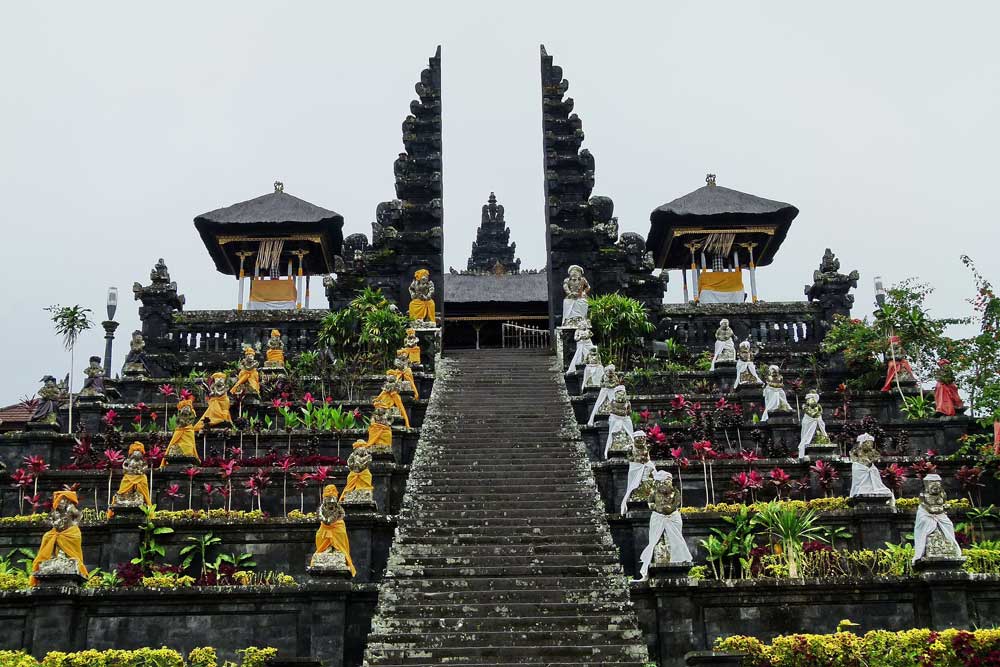
Pura Besakih, often referred to as Bali's Mother Temple, is the largest and most revered temple complex in Bali. Nestled on the slopes of the majestic Mount Agung, Pura Besakih is a significant site of worship and cultural heritage. In this comprehensive guide, we will discuss everything you need to know to plan your visit, from what to expect on-site to tips for an enriching experience.
Overview: Why Visit Pura Besakih?
Visiting Pura Besakih is not just a journey to see a magnificent temple; it’s an opportunity to immerse yourself in the rich tapestry of Balinese Hindu culture. As the most significant temple in Bali, Pura Besakih serves as a pivotal site for many ceremonial events and spiritual practices.
The entrance fee is 90,000 IDR for foreign visitors, which includes a knowledgeable local guide and a sarong for respectful attire. A visit here allows you to learn about Balinese Hinduism and witness the active, vibrant practices of local worshipers.
Getting There
Pura Besakih is conveniently located about 30 minutes north of Sidemen in East Bali, at the base of Mount Agung. While public transport isn't available, travelers can hire a private driver or use ride-sharing apps like Grab or Gojek to reach the temple.
Upon arrival, you’ll find spacious parking areas designated for cars and motorcycles. During busy festivals, these can fill up quickly, so plan accordingly.
Parking Information
- Scooter Fee: 5,000 IDR
- Car Fee: 10,000 IDR
- Payment: Only cash accepted for parking.
After parking, visitors can proceed to the ticket office where they can purchase admission tickets and receive a wristband and sarong. A shuttle bus will then transport you from the parking area to the temple entrance, navigating a steep uphill route.
Admission Costs
| Entry Fee | |
|---|---|
| Foreign Tourists | 90,000 IDR |
| Domestic Tourists | 50,000 IDR |
| Parking Charges | |
|---|---|
| Scooter/Motorbike | 5,000 IDR |
| Car | 10,000 IDR |
| Mini-Bus | 15,000 IDR |
| Bus/Truck | 50,000 IDR |
The admission fee includes a sarong and a guided tour, while visitors can opt to walk back down or take the shuttle for an additional fee of 20,000 IDR.
Dress Code: Respectful Attire
As a sacred site, appropriate dress is essential when visiting Pura Besakih. Shoulders and knees must be covered, and every visitor is required to wear a sarong, which is provided at the temple. This ensures respect for the customs and traditions observed in Balinese Hindu practice.
Ideal Visiting Times
Pura Besakih is open daily from 7 AM to 6 PM, excluding Nyepi, Bali’s Day of Silence.
For the best experience, visit on a clear day when Mount Agung is visible. The temple is often most picturesque early in the morning or late afternoon. If the weather changes, don’t be discouraged; the clouds can clear quickly, revealing stunning views of the temple and surrounding landscape.
Crowds and Peak Times
Pura Besakih is a popular destination, attracting both locals and tourists alike. However, the substantial grounds of the complex make it feel less crowded. Expect larger crowds during the Bhatara Turun Kabeh festival, typically held in the 10th lunar month, where hundreds of thousands of locals flock to the temple.
Highlights and Activities
Guided Tours
Taking advantage of the included guide enhances your visit significantly. While self-exploration is an option, having a knowledgeable local to explain the history and cultural significance of the temple complex enriches the experience. Our tour lasted around 30 minutes, which was filled with insightful details about the various structures.
Key Temples
Pura Besakih features a vast network of temples, with the Pura Penataran Agung being the most important. Its striking staircase leads to stunning gates, making it a popular photography spot. While non-Hindus can't enter this particular temple, you can appreciate its beauty from outside.
The complex houses around 18 public temples and at least 80 private ones, each dedicated to different deities such as Shiva, Brahma, and Vishnu.
Tips for a Successful Visit
Mind Your Manners: Treat this sacred site with respect. Adhere to local customs and be mindful of your surroundings.
Avoid Tourist Traps: While local vendors offer various items, there is no obligation to purchase anything beyond your admission ticket. Politely decline unwanted offers, particularly for ceremonial offerings that may be touted as mandatory.
Carry Cash: Although the entrance fee can be paid by card, smaller purchases and tips will require cash.
Nearby Attractions
If you're planning to visit Pura Besakih, consider combining your trip with nearby attractions for a more fulfilling experience.
Sidemen
Just a quick drive from the temple lies Sidemen, an idyllic area known for its beautiful rice paddies and authentic rural experiences. Enjoy trekking, participate in cultural workshops, or simply relax at local cafes.
Kintamani
A little further is Kintamani, home to the breathtaking Mount Batur. Here, you can hike the volcano for sunrise, enjoy views of the crater lake, and indulge in local dining experiences.
Conclusion
Pura Besakih stands as a beacon of Balinese cultural heritage and spirituality. A visit here goes beyond sightseeing—it's a journey into the heart of Bali's practices and beliefs. With this guide, you are well-equipped to explore Pura Besakih and fully appreciate its majesty and significance. Whether you're a spiritual seeker, a culture enthusiast, or a traveler exploring the island, this Mother Temple is undoubtedly a must-visit destination in Bali.



